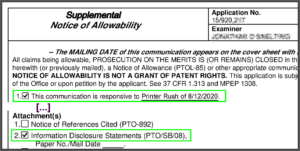Patentcenter, it is recalled, is the system that USPTO intends will replace PAIR and EFS-Web. Eventually USPTO will shut down PAIR and EFS-Web. USPTO has said from the beginning that one of its design imperatives for Patentcenter has been and is that every function and feature of PAIR and EFS-Web will be replicated into Patentcenter. One of the important features of EFS-Web is the web-based ADS.
In December of 2019, I noted that the web-based ADS feature of Patentcenter was defective. I was astonished to see that in Patentcenter, the drop-down list of Offices in which a priority application might have been filed omitted the European Patent Office. I reported this to the Electronic Business Center (“EBC”) and the EBC opened a “trouble ticket”.
Some fifty thousand times per year, an applicant files a patent application at the USPTO that claims priority from an EP application. If you use EFS-Web to file such an application, you can pick EPO from the appropriate drop-down list in the web-based ADS.
But as I say, astonishingly in Patentcenter the exact same drop-down list failed to include EPO as one of the choices.
USPTO says that one of the ways that beta testers of Patentcenter can report bugs in Patentcenter is by reporting the problem to the EBC. In my case, in December of 2019 I not only reported this problem to the EBC, but I took the extra step of opening an EBC trouble ticket. But it is clear that this bug reporting path does not work. In six months I never heard back from the EBC about this trouble ticket.
Then USPTO made Patentcenter open to all users. I launched the Patentcenter listserv and one of the earliest topics discussed was this defect in Patentcenter. I launched the Patentcenter trouble ticket page and this bug got listed as CP9. I blogged about this bug here.
Now the USPTO has quietly fixed this bug in Patentcenter.
I have three reactions to this development.
First, my first reaction is yes, of course it is a good thing that the Patentcenter developers finally did get around to fixing this defect in Patentcenter. Fifty thousand times per year an applicant in the USPTO claims priority from an EP application.
Second, and I mean this as a very serious question, why did it take six months for the Patentcenter developers to get around to fixing this bug? It speaks poorly for the USPTO that even though USPTO says one of the ways to report Patentcenter bugs is by reporting them to the EBC, the fact is that reporting a bug to the EBC seems to go into a black hole and the bug does not get fixed. It is unfortunate that what it took to get the Patentcenter developers to take this seriously was the formation of a listserv of 150 power users, and for the listserv to apply pressure at a very high level within the USPTO.
Third, and I also mean this very seriously, I feel it is very poor customer relations that I had to find out completely by accident that the USPTO finally got around to fixing this bug. It would be a matter of common courtesy for the USPTO to respond to the listserv to let the listerv know that the USPTO had gotten around to fixing this bug, and thus that CP9 could be closed. I learned of this only because one of the listserv members stumbled upon the newly corrected bug, and brought it to my attention.




